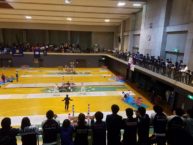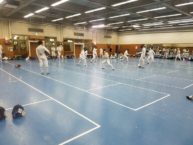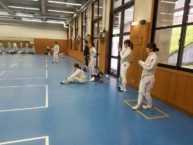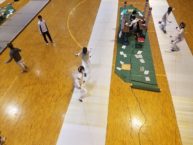Ever since middle school, the sport of fencing has been an important part of my life, so naturally I picked fencing as my CIP. The Doshisha fencing team practices every day but Monday for about 2 hours. I’ve only been going to Tuesday and Thursday practices because I have to take a 70 minute bus ride to get to Doshisha’s Kyotanabe campus for practice. Much like in America, practice is composed of some warm-up, followed by free bouting.
Practicing with the fencing club was a great opportunity to learn about Japanese society. For example, like most sports club in Japan, younger members are expected to use formal language when talking to older members. Moreover, members usually only socialize with other people in the same age group. I’ll never forget my first night of practice when I asked a freshman if he wanted to sit together on the bus ride home. He was bewildered that I even considered asking him instead of another Junior (even though I hadn’t talked to the other Juniors yet!).
That said, the most important thing I’ve learned from the fencing club is that no matter how different two cultures are, some things are the same around the world. Sore legs after practice, triumphant screams after a successful touch – these sorts of experiences and emotions are shared between fencers in Japan, America, and around the world. In short the love and dedication we share does not just belong to one culture. It is universal.
Thus, my advice to the students that follow in my footsteps at KCJS is to remember that no matter how strange and alien Japan might seem at times, remember that you certainly have some common ground with the people and culture around you. Explore those similarities and differences by getting involved. Immerse yourself. Even if you don’t know what to say, even if you aren’t confident in your Japanese – dive in head first. I know it might be scary, but I promise that no matter how scary it is, it will be even more rewarding.




